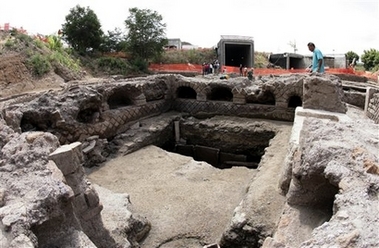Archaeologists excavate ancient tannery
(AP)Updated: 2007-08-01 14:26
ROME - Archaeologists excavating an ancient tannery believed to be the largest ever found in Rome said Tuesday they might need to move the entire work site, which is being threatened by railroad construction. The 1,255-square-yard complex includes a tannery dating to the second or third century, as well as burial sites and part of a Roman road.
 The tunnels of a high-speed railway are seen in the background of the ruins of an ancient Roman tannery dated back to the 2nd-3rd century A.D. in Rome, Monday, July 31, 2007. [AP]  |
The complex, located in the Casal Bertone area in the outskirts of Rome, lies between two tunnels of a high-speed railway being built to link Rome and Naples, said Stefano Musco, the director of the archaeological excavations.
"(Even though) there are only 109 yards of railway left to build, the archaeological complex has no chance of surviving," Musco told reporters during a tour of the dig. "Either it stays the way it is and the works are stopped or, if the railway must be built, these remains will have to be cut out and rebuilt entirely."
He said they might be moved to a nearby park.
If the complex is moved, experts would scan the area with a 3-D laser to help archaeologists replace the items in their exact positions, Musco said. The archaeologist, who declined to say how much the project would cost, said technical problems might arise from the fragmentation of the structures and the vastness of the site.
"This is an ancient industrial area - not a craftsman's workshop, but a big complex where several people used to work," he said.
Musco said the project will have to be approved by the Italian Culture Ministry. Officials at the ministry said the project would have to be discussed by a panel of experts.
"I would obviously prefer not to touch anything," Musco said. "It will be quite frustrating to see this thing being taken away."
The system of roads that spread from the capital across the ancient empire is considered one of ancient Rome's greatest engineering feats, and today's transport networks in Italy often closely follow the routes chosen by builders two millennia ago.
|
|
|
||
|
||
|
|